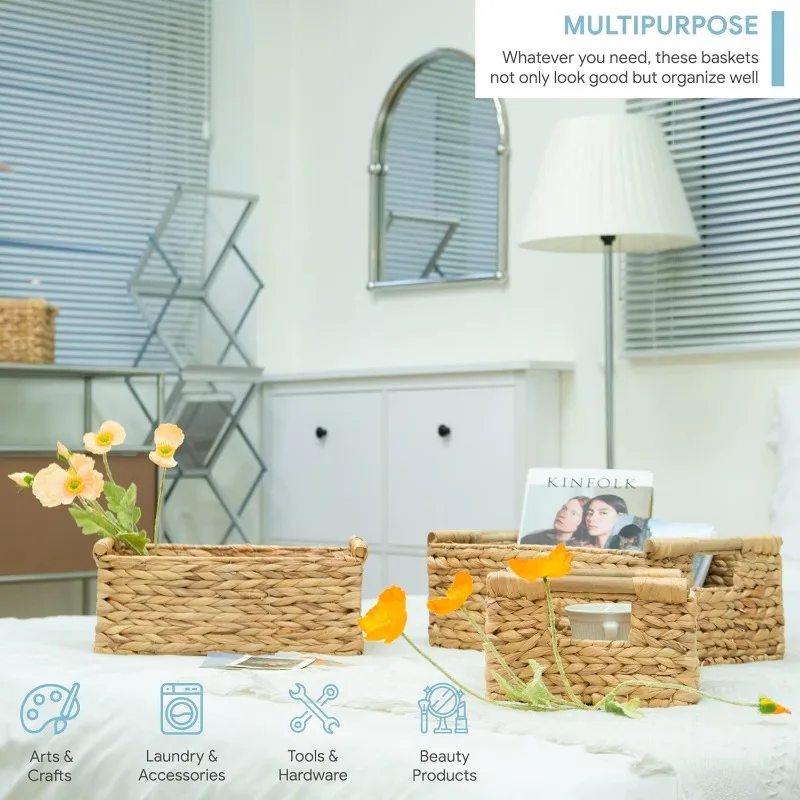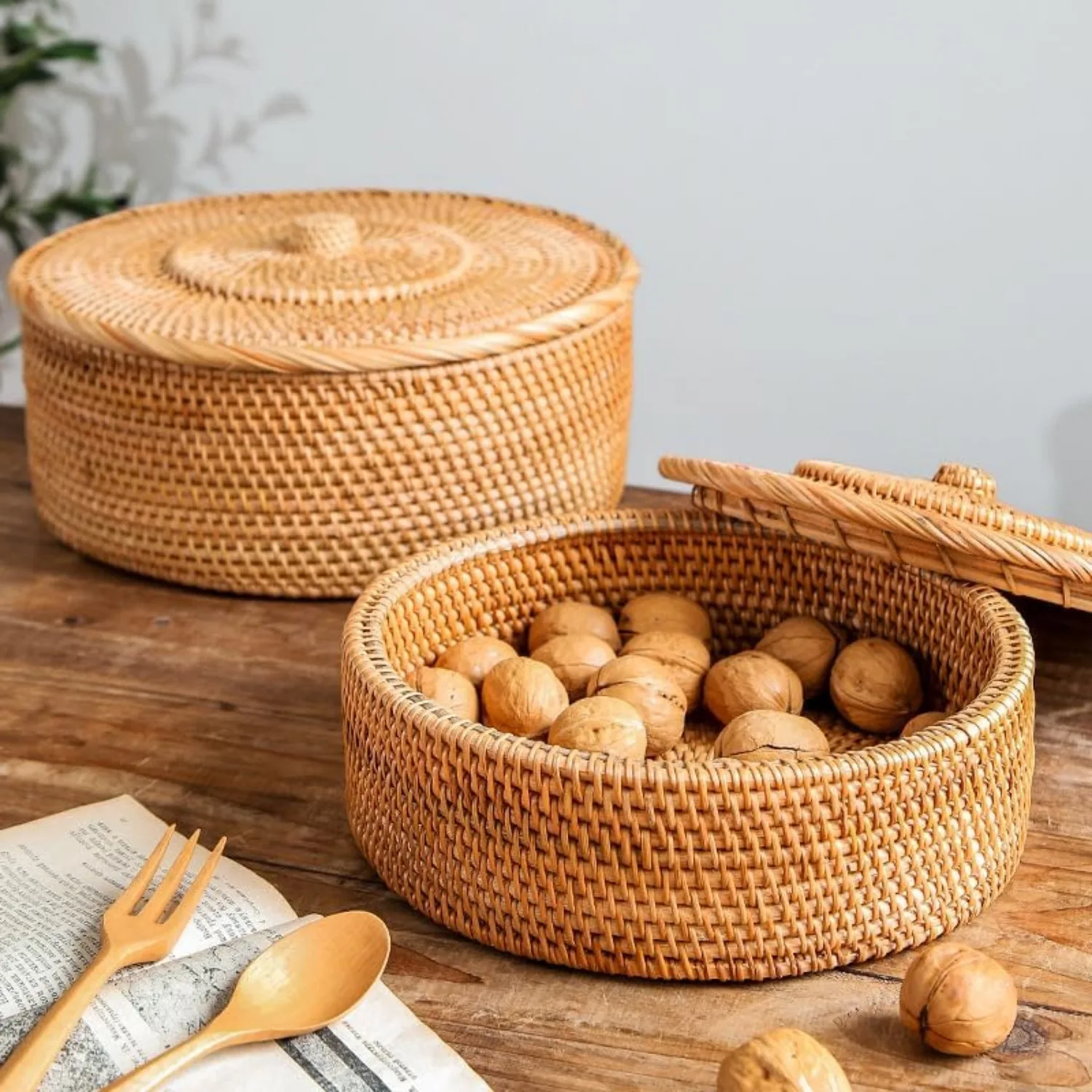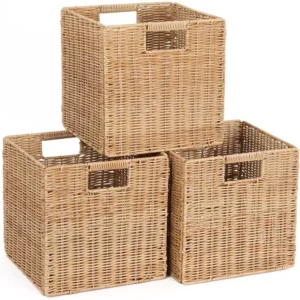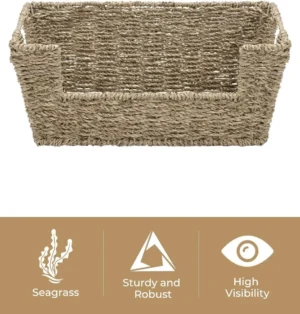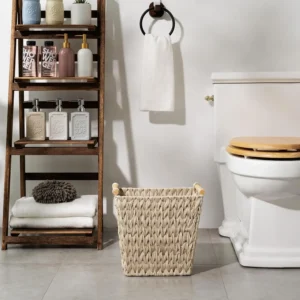Introduction: Understanding Wicker Materials for Home Decor
When exploring home storage and furniture options, the term “wicker” often comes up, but many people don’t realize that wicker isn’t actually a material itself. Wicker refers to a weaving technique that creates those distinctive patterns we recognize in baskets, furniture, and decor items. The materials used in this weaving process fall into two main categories: natural wicker and synthetic wicker.
Natural wicker materials have been used for thousands of years, with evidence of woven items dating back to ancient Egypt. These plant-based materials create pieces with organic texture and warmth that bring a touch of nature indoors. On the other hand, synthetic wicker is a more recent innovation, designed to mimic the look of natural materials while offering improved durability and weather resistance.
Today, both materials enjoy tremendous popularity in home decor. The resurgence of interest in natural textures has elevated wicker from occasional outdoor furniture to statement pieces found throughout modern homes. Meanwhile, advancements in synthetic materials have created options that closely resemble their natural counterparts while addressing many of their limitations.
What is Wicker?
Wicker is a weaving technique used to create furniture and decorative items, not a specific material. Items can be made from natural plant fibers or synthetic alternatives, each with distinct properties and benefits.
In this comprehensive guide, we’ll explore the differences between natural and synthetic wicker materials to help you determine which option best suits your home, lifestyle, and personal preferences. At Tidy Treasure, we specialize in selecting premium wicker baskets that combine beautiful aesthetics with practical functionality, making us particularly attuned to the nuances of these versatile materials.
What is Natural Wicker? Materials, Features, and Characteristics
Natural wicker encompasses a variety of plant-based materials that have been harvested, processed, and woven into furniture and decor items. These organic materials create pieces with authentic character, unique variations, and a connection to traditional craftsmanship.
The most common natural wicker materials include:
- Rattan: A vine-like palm that grows in tropical regions, featuring a solid core with natural flexibility and strength. Rattan can be split into thin strips (known as peel) or used as whole poles.
- Bamboo: A fast-growing grass with hollow stems that provides exceptional strength and sustainability.
- Reed: Typically harvested from wetlands, reed has hollow stems that create lightweight yet sturdy woven items.
- Seagrass: A durable marine plant with natural water resistance, often used for baskets and mats.
- Willow: Flexible young branches from willow trees that create distinctive rustic pieces with excellent durability.
The harvesting and processing of these materials involves careful selection of mature plants, followed by cutting, drying, and sometimes steaming to increase flexibility. Craftspeople often sort materials by size and quality before the weaving process begins. The most skilled artisans understand how different materials behave and how to work with their natural properties to create beautiful, functional pieces.
Natural wicker’s visual and tactile characteristics are truly unique. Each piece displays subtle variations in color, texture, and thickness that reflect its organic origins. These variations aren’t flaws but rather the authentic character that mass-produced items often lack. The natural golden-brown tones of rattan cores, the greenish hues of fresh seagrass, and the rich browns of willow all develop distinctive patinas over time, adding to their appeal.
When exploring rattan baskets, you’ll notice that cores (the solid center of the rattan stem) provide structural strength, while the outer peel offers flexibility for tight weaving patterns. This combination creates pieces that are simultaneously sturdy and intricate—a hallmark of quality natural wicker construction.
The popularity of eco-friendly wicker basket materials continues to grow as consumers seek sustainable alternatives to plastic products. Natural wicker connects users to ancient traditions while offering renewable material options for today’s environmentally conscious homes.
Understanding Synthetic Wicker: Types, Technology, and Innovation
Synthetic wicker (also called resin wicker or all-weather wicker) represents modern technology’s answer to the limitations of natural materials. These manufactured alternatives are designed to replicate the appearance and texture of natural wicker while offering enhanced durability and weather resistance.
High-Density Polyethylene (HDPE)
The premium choice in synthetic wicker, HDPE offers exceptional durability and resistance to environmental factors. This material maintains its integrity even under harsh conditions, resisting fading, cracking, and deterioration. HDPE synthetic wicker typically features:
– Superior UV stabilization
– High tensile strength
– Excellent color retention
– Environmentally friendly manufacturing (often using recycled materials)
– The most realistic texture among synthetic options
Polyethylene (PE)
Standard PE represents the mid-range option for synthetic wicker. It provides good durability at a more accessible price point than HDPE. PE synthetic wicker offers:
– Good weather resistance
– Moderate UV stability
– Flexible fibers that resist cracking
– A reasonable balance between quality and affordability
Polyvinyl Chloride (PVC)
Representing the budget end of synthetic wicker, PVC provides basic functionality but lacks some of the premium qualities of other options. PVC synthetic wicker features:
– Low cost production
– Basic weather resistance
– Less realistic texture
– Lower durability in extreme conditions
– Tendency to become brittle over extended UV exposure
Manufacturing innovations have dramatically improved the quality and appearance of synthetic wicker over the past decade. Advanced extrusion techniques now create fibers with varied thicknesses, textures, and even simulated grain patterns that closely mimic natural materials. Multi-layer color technology embeds pigment throughout the material rather than just on the surface, significantly improving fade resistance and longevity.
Modern synthetic wicker also incorporates specialized additives that provide UV protection, flexibility enhancers, and antimicrobial properties. Some manufacturers have developed proprietary formulations that deliver specific benefits, such as exceptional color stability or improved temperature resistance to prevent the material from becoming uncomfortably hot in direct sunlight.
The most recent innovations include eco-friendly synthetic wicker made from recycled materials or biodegradable polymers, addressing environmental concerns while maintaining performance characteristics. For more information about these advancements, our comprehensive synthetic vs natural wicker guide provides detailed insights into the latest technologies.
Durability Face-Off: Comparing Lifespan and Resilience
When investing in wicker items for your home, understanding the durability differences between natural and synthetic options becomes crucial for making informed decisions.
Natural Wicker Durability
Natural wicker materials possess inherent beauty but come with several vulnerability factors that affect their longevity:
Moisture Sensitivity: Perhaps the biggest challenge for natural wicker is its susceptibility to water damage. Excessive moisture causes natural fibers to swell, warp, and potentially develop mold or mildew. Even high humidity environments can gradually compromise structural integrity.
UV Vulnerability: Extended sun exposure causes natural wicker to dry out, becoming brittle and prone to cracking or splitting. The natural pigmentation also fades unevenly, sometimes resulting in a weathered appearance that may or may not be desirable depending on your aesthetic preferences.
Structural Concerns: Without proper care, natural wicker items typically develop issues like:
– Splitting along fiber grains
– Unraveling at weave endpoints
– Loosening joints where pieces connect
– Color inconsistencies from environmental exposure
Under ideal indoor conditions with moderate humidity and limited sun exposure, quality natural wicker furniture can last 10-20 years. However, when placed in challenging environments or without proper maintenance, this lifespan may decrease to 3-5 years.
Synthetic Wicker Durability
Synthetic wicker materials are specifically engineered to overcome the limitations of their natural counterparts:
Weather Resistance: High-quality synthetic wicker, particularly HDPE varieties, can withstand rain, snow, and humidity without absorbing moisture or developing mold. This makes it ideal for outdoor patios, porches, or indoor spaces with humidity fluctuations.
UV Stability: Premium synthetic materials incorporate UV inhibitors throughout the material (not just surface treatments), allowing them to maintain structural integrity and color even with years of sun exposure. Better options show minimal fading after 5+ years of outdoor use.
Physical Resilience: Synthetic wicker typically offers:
– Higher tensile strength than natural materials
– Greater flexibility without breaking
– Better resistance to impact damage
– Consistent performance in temperature extremes
The lifespan of quality synthetic wicker furniture commonly ranges from 7-15 years for outdoor applications and potentially 20+ years for indoor use. However, budget synthetic options (particularly PVC) may deteriorate much faster, sometimes showing significant degradation within 2-3 years of outdoor exposure.
For specific comparison metrics and performance expectations in different environments, our detailed analysis of synthetic vs natural wicker provides expanded information based on material testing and real-world performance.
Maintenance Requirements: Care Tips for Both Materials
The maintenance demands of your wicker pieces can significantly impact your long-term satisfaction with them. Here’s how natural and synthetic wicker compare in terms of care requirements:
Natural Wicker Care
Regular Cleaning:
– Dust weekly using a soft brush attachment on your vacuum
– Wipe surfaces with a dry microfiber cloth to prevent dust buildup
– Avoid getting natural fibers wet during routine cleaning
Handling Spills:
– Blot (don’t rub) liquid spills immediately with absorbent cloth
– For minor stains, lightly dampen cloth with water and mild soap
– Dry thoroughly with clean towels and enhance air circulation
Seasonal Maintenance:
– Apply food-grade mineral oil or boiled linseed oil annually
– Focus on dry-looking areas that may be prone to cracking
– Use small amount of oil on soft cloth, working into fibers
– Allow pieces to fully dry/cure before using (typically 24 hours)
Storage Recommendations:
– Store in climate-controlled environment when not in use
– Avoid direct contact with concrete floors (use pallets/cardboard)
– Never cover with plastic (traps moisture); use breathable cotton sheets
– Apply protective oil treatment before long-term storage
Synthetic Wicker Care
Regular Cleaning:
– Rinse with garden hose or wipe with damp cloth
– Use mild dish soap solution for general cleaning
– Annual deep cleaning with gentle pressure washer (low setting)
Handling Stains:
– Most stains wipe away with soap and water
– For stubborn stains, use diluted white vinegar solution
– Rinse thoroughly after cleaning to remove residue
Seasonal Considerations:
– No special seasonal treatments required
– Consider moving darker-colored pieces to shade during peak summer
– Check for loose strands and tuck them back into the weave
Repair Options:
– Loose strands can be secured with clear outdoor-rated adhesive
– Small breaks can be reinforced with matching zip ties (hidden underneath)
– Replacement parts often available from manufacturers
Time Investment Comparison
Natural wicker requires approximately 3-4 hours of dedicated maintenance per year, plus immediate attention to spills or moisture exposure. Synthetic wicker typically demands only 1-2 hours annually, with much greater forgiveness for delayed cleaning or maintenance.
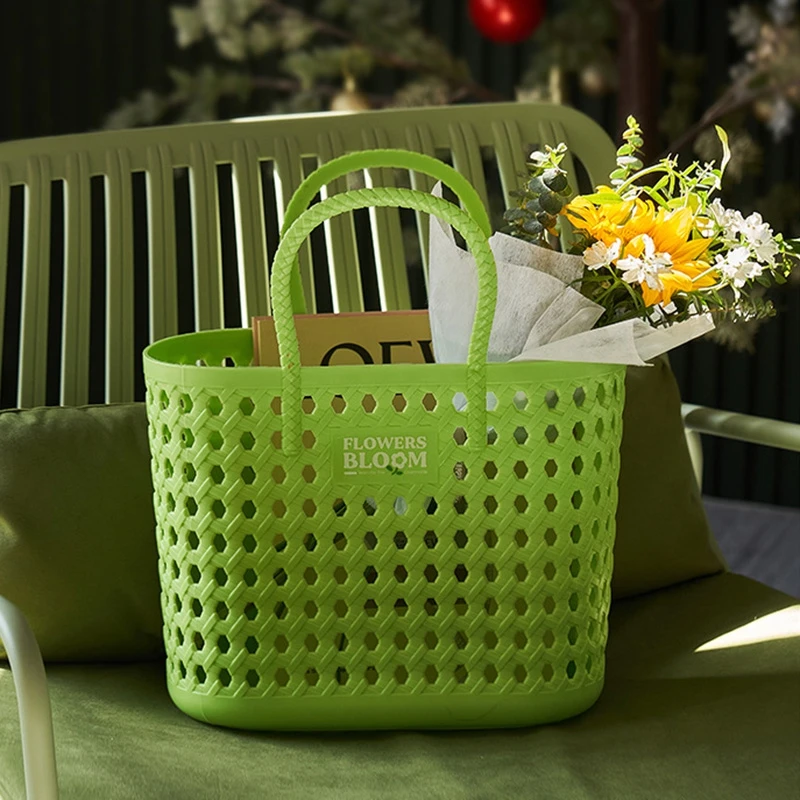
For comprehensive guidance on extending the life of your wicker items, our resource on proper basket care maintenance offers detailed cleaning techniques for different wicker materials and specialized treatments for preserving their beauty and functionality.
Aesthetic Appeal: Visual and Tactile Differences
The visual and tactile qualities of wicker materials often become the deciding factor for many homeowners. Both natural and synthetic options offer distinctive aesthetic characteristics that suit different design preferences and home styles.
Natural Wicker Aesthetics
Natural wicker possesses an inherent visual warmth that comes from its organic origins. Each piece features subtle variations in:
- Color depth: Natural materials display rich tonal variations even within a single strand, creating visual depth that catches light in complex ways.
- Textural character: Tiny irregularities in fiber thickness and surface create tactile interest that feels authentic and artisanal.
- Patina development: Over time, natural wicker develops a rich patina that many designers prize, deepening in color and developing a gentle sheen from use.
The color palette of natural wicker typically ranges from pale wheat tones to deep amber browns, depending on the specific plant material used. These earthy tones complement design styles like:
- Coastal and beach-inspired interiors
- Bohemian and eclectic spaces
- Farmhouse and rustic décor
- Traditional and colonial aesthetics
- Tropical and island-inspired designs
Many homeowners appreciate that natural wicker tells a visual story of its creation—the material’s journey from plant to finished product remains evident in its appearance, connecting users to artisanal traditions and natural materials.
Synthetic Wicker Aesthetics
Modern synthetic wicker has evolved dramatically in its visual appeal, now offering:
- Color consistency: Uniform coloration throughout each strand ensures a cohesive look, particularly important in larger furniture pieces.
- Expanded color options: Beyond natural tones, synthetic wicker comes in virtually any color, from bright whites to deep blacks and bold accent colors.
- Texture replication: Advanced manufacturing creates remarkably realistic textures that mimic specific natural materials like split rattan or seagrass.
The precision of synthetic wicker lends itself beautifully to:
– Contemporary and modern spaces
– Minimalist design approaches
– Indoor-outdoor transitional areas
– Commercial and high-traffic environments
– Color-coordinated design schemes
The best synthetic products now incorporate subtle variations intentionally woven into the manufacturing process, mimicking the natural irregularities that give traditional wicker its character while maintaining consistency where it matters structurally.
For those interested in exploring different aesthetic possibilities, our collection of woven storage baskets showcases how various wicker materials translate into beautiful yet practical home storage solutions that enhance different interior design styles.
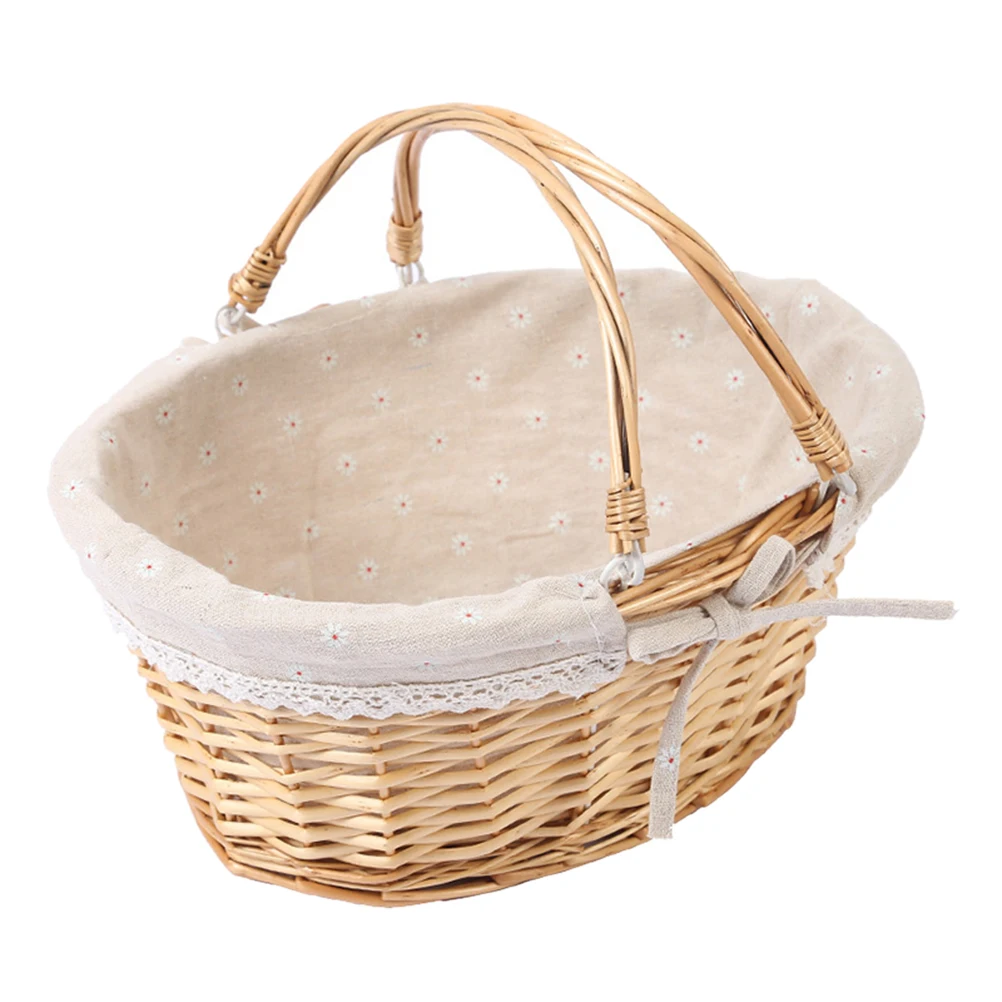
Weather and Environmental Resistance: Indoor vs. Outdoor Suitability
The ability to withstand environmental challenges represents one of the most significant differences between natural and synthetic wicker materials. Understanding these differences helps ensure your wicker items remain beautiful and functional regardless of where they’re placed.
Natural Wicker Environmental Tolerance
Natural wicker performs best under controlled conditions:
Optimal Environment:
– Indoor settings with stable humidity (40-60%)
– Temperature range of 60-80°F (15-27°C)
– Limited direct sunlight exposure
– Protection from moisture sources
Weather Vulnerability:
– Moisture absorption leads to warping, mold growth, and structural weakening
– UV rays cause drying, color fading, and fiber brittleness
– Extreme temperature fluctuations stress fiber connections
– High humidity environments accelerate deterioration
Natural wicker can occasionally work in protected outdoor spaces like covered porches or screened patios in dry climates, but requires vigilant maintenance and seasonal storage. Even brief exposure to rain can begin deterioration that’s difficult to reverse.
Synthetic Wicker Environmental Performance
Synthetic wicker offers substantially improved environmental resistance:
Weather Capabilities:
– Water-resistant construction prevents moisture absorption
– UV-inhibiting additives protect against solar degradation
– Operating temperature range of -20°F to 120°F (-29°C to 49°C) for premium options
– Resistance to salt air in coastal environments
Environmental Advantages:
– Can remain outdoors year-round in most climates
– Withstands seasonal weather changes without special protection
– Maintains structural integrity during temperature fluctuations
– Resists mold, mildew, and insect damage
Not all synthetic wicker performs equally in extreme environments. HDPE offers superior performance in challenging conditions, while PVC may deteriorate more quickly when faced with temperature extremes or intense UV exposure.
Regional Climate Considerations
Your local climate should influence material selection:
- Hot, humid regions (Florida, Gulf Coast): Synthetic wicker strongly recommended for outdoor use and even for indoor spaces with humidity fluctuations.
- Hot, dry regions (Arizona, Nevada): Synthetic wicker prevents cracking from excessive dryness outdoors, though natural wicker performs well indoors with proper humidity management.
- Temperate climates (Pacific Northwest, Mid-Atlantic): Protected outdoor areas might accommodate natural wicker during summer months only, with synthetic preferred for year-round exposure.
- Cold regions (Northeast, Midwest): Natural wicker becomes particularly brittle in winter conditions, while quality synthetic withstands freeze-thaw cycles.
For specialized applications like bathroom or laundry organization, the question of material safety in humid environments becomes particularly important. Our guide on is synthetic wicker safe laundry addresses specific concerns about material performance in moisture-rich household environments.
Comfort and Ergonomics: The Feel Factor
While appearance often drives initial interest in wicker items, how they feel during everyday use significantly impacts long-term satisfaction. Both natural and synthetic materials offer distinct tactile experiences that affect comfort and usability.
Natural Wicker Feel
Natural wicker materials possess inherent physical qualities that create a distinctive sensory experience:
Flexibility and Give:
Natural fibers have an organic elasticity that allows slight movement when pressure is applied. This subtle “give” creates a responsive feel in seating, making natural wicker furniture surprisingly comfortable even without cushions. Basket handles made from natural wicker conform slightly to your grip, making them ergonomically pleasant for carrying.
Surface Texture:
The tactile quality of natural wicker includes microscopic texture variations that provide pleasant grip without roughness. Quality natural wicker should feel smooth against skin without snags or sharp edges, yet maintain enough texture to prevent items from sliding off surfaces.
Temperature Properties:
Natural materials stay relatively neutral in temperature, warming slightly to the touch rather than feeling cold like metals or some plastics. This makes natural wicker comfortable to touch even in air-conditioned environments.
Aging Characteristics:
As natural wicker ages, it often becomes more supple in frequently touched areas while potentially becoming more brittle in others. This creates a personalized “wear pattern” that many users find adds character but can eventually affect comfort if not maintained.
Synthetic Wicker Feel
Modern synthetic wicker has been engineered to address comfort considerations:
Engineered Flexibility:
Contemporary synthetic wicker incorporates carefully calibrated flexibility to mimic the give of natural materials. Premium options balance rigidity for support with just enough yield to conform comfortably to body contours or gripping hands.
Texture Development:
Advanced manufacturing now creates multi-dimensional textures that replicate the tactile experience of natural materials. Better synthetic products avoid the slick, plastic feel of earlier generations, instead offering a pleasant grip surface and visual dimension.
Temperature Stability:
Synthetic wicker generally maintains more stable temperature properties than natural fibers, though darker colors can absorb significant heat in direct sunlight. Some premium synthetics incorporate heat-reflective technologies to minimize this effect.
Consistency Over Time:
Unlike natural wicker, quality synthetic materials maintain their original comfort characteristics with minimal change over years of use. This predictable performance ensures long-term satisfaction but lacks the “breaking in” quality some appreciate in natural materials.

Cost Analysis: Initial Investment vs. Long-Term Value
Understanding the financial implications of your wicker material choice helps ensure your investment aligns with both your budget and long-term needs.
Price Range Comparison
| Item Type | Natural Wicker Average Price | Synthetic Wicker Average Price |
|---|---|---|
| Storage Basket (Medium) | $35-75 | $25-65 |
| Laundry Hamper | $60-150 | $45-120 |
| Accent Chair | $150-500 | $120-450 |
| Dining Set (4 chairs) | $800-2,500 | $600-2,200 |
| Sectional Sofa | $1,500-4,000 | $1,200-3,500 |
Prices reflect quality mid-range options; both budget and premium outliers exist outside these ranges.
Factors Affecting Cost
Several key factors influence the price of both natural and synthetic wicker products:
Natural Wicker Cost Factors:
– Material source and rarity (some natural fibers command premium prices)
– Harvesting complexity and sustainable practices
– Craftsmanship level and weaving intricacy
– Treatment processes for improved durability
– Brand reputation and artisan recognition
Synthetic Wicker Cost Factors:
– Material quality (HDPE commands premium over PVC)
– Manufacturing technology sophistication
– Warranty length and coverage
– UV resistance rating and additives
– Frame materials (aluminum vs. steel)
Long-Term Value Considerations
Initial purchase price tells only part of the financial story. Consider these long-term factors:
Replacement Frequency:
Natural wicker typically requires replacement every 5-10 years in average indoor conditions, while quality synthetic options can last 10-20 years even in challenging environments.
Maintenance Supplies:
Natural wicker requires specialized cleaners, oils, and protective treatments that typically cost $20-40 annually. Synthetic wicker generally needs only basic soap and water, representing minimal ongoing expense.
Potential Repair Costs:
Repairs to natural wicker often require specialized skills and can cost 25-40% of the item’s original price. Synthetic wicker repairs are generally simpler and less expensive, often achievable with basic DIY solutions.
Resale Value:
High-quality natural wicker from recognized brands or artisans can maintain 30-50% of its value after several years if well-maintained. Synthetic wicker typically retains only 15-30% of its original value in the secondary market.
For those seeking an optimal balance of value and function, our collection of wicker storage baskets offers options across different price points and materials, making it easier to find the right combination of quality and affordability for your needs.
Sustainability and Environmental Impact
Environmental considerations increasingly influence purchasing decisions, making it important to understand the ecological implications of both natural and synthetic wicker materials.
Natural Wicker Environmental Factors
Renewable Resource Status:
Most natural wicker materials come from renewable plant sources that regrow relatively quickly. Rattan, a primary wicker material, reaches harvesting maturity in 5-7 years, while bamboo can be harvested in as little as 3-5 years. This rapid regrowth makes them more sustainable than hardwoods that take decades to mature.
Harvesting Practices:
The sustainability picture becomes more complicated when considering harvesting methods. Responsible harvesting allows plant bases to regenerate and maintains forest ecosystems. However, increasing demand has led to some unsustainable practices, including over-harvesting that threatens natural habitats in Southeast Asia where many wicker materials originate.
Biodegradability:
Natural wicker products offer the significant advantage of being biodegradable at the end of their useful life. When disposed of, they decompose naturally without contributing to long-term waste problems.
Carbon Considerations:
While growing, plants used for natural wicker capture carbon dioxide. However, global shipping of raw materials and finished products creates a significant carbon footprint, particularly for items manufactured in Asia and sold in North American or European markets.
Synthetic Wicker Environmental Factors
Raw Material Sources:
Most synthetic wicker derives from petroleum-based plastics, representing a non-renewable resource utilization. However, innovations in recycled and partially plant-based polymers are improving this aspect of synthetic wicker’s environmental profile.
Manufacturing Impact:
Synthetic wicker production involves energy-intensive manufacturing processes and potential chemical emissions. More responsible manufacturers have implemented closed-loop systems that minimize waste and energy consumption.
Recyclability:
High-quality synthetic wicker materials like HDPE are technically recyclable, though the mixed materials used in most furniture pieces complicate the recycling process. PVC wicker presents greater recycling challenges and potential environmental hazards.
Longevity as Sustainability:
The extended lifespan of quality synthetic wicker offers an often-overlooked environmental benefit. A synthetic piece that lasts 15 years creates less overall environmental impact than three natural wicker pieces replaced every 5 years, particularly when considering the cumulative manufacturing and shipping impacts.
Eco-Friendly Innovations:
Recent developments include synthetic wicker made from recycled ocean plastics, post-consumer waste, and bioplastic components. These innovations significantly reduce environmental impact while maintaining performance benefits.
For environmentally conscious consumers seeking natural material options, our rattan storage baskets collection features pieces made from sustainably harvested materials with traditional craftsmanship techniques that minimize environmental impact.
Quick Decision Guide: When to Choose Each Material
To help simplify your decision process, here’s a scenario-based guide for choosing between natural and synthetic wicker:
Choose Natural Wicker When:
- You’re furnishing indoor living spaces with controlled temperature and humidity
- Your design aesthetic embraces organic textures and natural variations
- You value artisanal craftsmanship and traditional weaving techniques
- Your space receives minimal direct sunlight through windows
- You’re willing to provide regular maintenance to preserve material quality
- You’re creating a warm, inviting atmosphere where tactile authenticity matters
- You’re furnishing formal spaces like dining rooms or living rooms used primarily for entertaining
- You appreciate pieces that develop character and patina over time
Choose Synthetic Wicker When:
- You need furniture for outdoor spaces like patios, decks, or poolside areas
- Your home includes high-moisture areas such as bathrooms, laundry rooms, or sunrooms
- You have young children or pets who may spill liquids or rough-handle furniture
- You desire minimal maintenance requirements with maximum durability
- Your furniture will be exposed to temperature extremes throughout the year
- You prefer consistent appearance without variation or aging changes
- You need pieces for rental properties or vacation homes with minimal oversight
- You’re furnishing spaces that receive intense sunlight through large windows
Consider Mixed Material Approaches:
- Use synthetic wicker for the furniture frame with natural wicker accents
- Choose natural wicker for indoor storage baskets and synthetic for outdoor or bathroom use
- Pair natural wicker side tables with synthetic wicker seating for optimal functionality
- Select natural wicker for decorative wall pieces and synthetic for functional items
For more detailed guidance tailored to your specific needs, our comprehensive guide on how to choose between synthetic natural wicker provides additional scenarios and considerations. Similarly, our resource on choosing between natural synthetic wicker offers complementary advice to help refine your selection process.
Specialty Applications: Beyond Furniture
While furniture often dominates discussions about wicker materials, both natural and synthetic wicker excel in numerous specialty applications throughout the home. Understanding material performance in these specialized uses can help you make optimal choices.
Storage Solutions Comparison
Bathroom Organizers:
– Natural wicker requires careful placement away from direct water sources and benefits from bathroom ventilation
– Synthetic wicker withstands humidity fluctuations and occasional water splashes without concern
Kitchen Storage:
– Natural wicker brings warmth to kitchen spaces but requires protection from cooking moisture and food spills
– Synthetic wicker offers easy cleaning for pantry organization and withstands kitchen humidity variations
Laundry Hampers:
– Natural wicker provides aesthetic appeal but may absorb odors over time and requires protection from damp clothing
– Synthetic wicker resists moisture from damp towels or clothes and offers easy cleaning for occasional mildew prevention
Closet Organization:
– Natural wicker creates beautiful storage for seasonal accessories and folded garments in climate-controlled closets
– Synthetic wicker works well even in closets with humidity fluctuations, such as those in bathrooms or exterior walls
Decorative Applications
Beyond practical storage, wicker materials enhance home decor in creative ways:
Wall Decor:
Both materials create striking wall arrangements, with natural wicker offering authentic texture and synthetic providing consistent sizing for precise patterns.
Lampshades and Lighting:
Natural wicker creates beautiful filtered light patterns but requires careful distance from high-wattage bulbs. Synthetic options offer similar aesthetics with greater heat resistance.
Room Dividers:
Woven screens and dividers in both materials create visual separation while maintaining airflow. Natural options provide greater sound absorption, while synthetic versions offer better stability and consistent appearance.
Small Accent Pieces:
Picture frames, mirror surrounds, and decorative orbs showcase the versatility of wicker techniques. Natural materials excel in creating organic, one-of-a-kind accents, while synthetic options maintain precise dimensions and resist damage in high-traffic display areas.
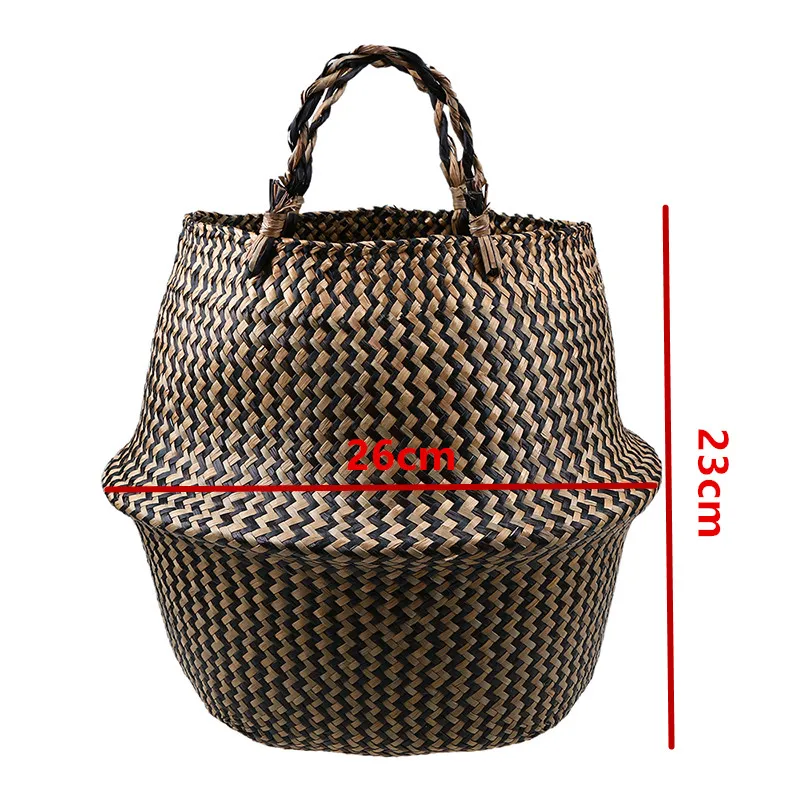
For specialized applications in bathroom spaces, our wicker waste baskets collection offers options specifically designed for moisture resistance and easy cleaning, while our guide on natural vs synthetic wicker laundry provides detailed information about material performance in laundry applications.
Black Wicker Baskets, Rattan Storage Baskets, Tall Wicker Baskets, Wicker Shelf Baskets, Woven Storage Baskets
5-Tier Distressed Black Wood Frame Storage Tower with Removable Wicker Baskets for Home Organization$715.80 Select options This product has multiple variants. The options may be chosen on the product pageWicker Laundry Baskets, Woven Laundry Baskets, Woven Storage Baskets
$392.02 Select options This product has multiple variants. The options may be chosen on the product pageRattan Shelf Baskets, Rattan Storage Baskets, Small Wicker Baskets, Square Wicker Baskets
Square Plastic Wicker Storage Baskets Set of 3 with Collapsible Design for Cube Storage Organization$185.47 Select options This product has multiple variants. The options may be chosen on the product pageWicker Baskets with Handles, Wicker Storage Baskets, Woven Storage Baskets
$137.92 Select options This product has multiple variants. The options may be chosen on the product page- $119.02 Select options This product has multiple variants. The options may be chosen on the product page
Large Wicker Laundry Baskets, Tall Wicker Baskets, Woven Laundry Hampers, Woven Storage Baskets
$130.54 Select options This product has multiple variants. The options may be chosen on the product page
How to Identify Quality in Both Materials
Regardless of which material you choose, knowing how to identify quality construction ensures your wicker purchases provide lasting satisfaction. Here are the key indicators to assess when evaluating both natural and synthetic wicker products:
Quality Indicators for Natural Wicker
Weave Assessment:
– Tight, consistent weaving patterns without gaps or irregularities
– Even tension throughout the piece, particularly at corners and curves
– Clean transitions between different weave patterns
– No loose ends or protruding fibers
Material Quality:
– Consistent diameter in the strands used throughout
– Smooth fiber surface without splinters or rough patches
– Natural luster rather than artificial-looking shine
– Flexibility without breaking when gently flexed
Construction Details:
– Reinforced corners and edges for structural integrity
– Double wrapping at stress points where fibers change direction
– Secured endpoints that won’t easily unravel
– Smooth, sanded surfaces without sharp edges
Framework Analysis:
– Solid wood frame beneath woven elements for furniture
– Tightly wrapped joints where frame pieces meet
– No squeaking or movement when pressure is applied
– Evidence of traditional joinery techniques
Quality Markers for Synthetic Wicker
Material Verification:
– Consistent coloration throughout the fiber (cut a small hidden section to check)
– UV protection claims backed by warranty periods
– Appropriate flexibility without cracking or stretching
– Matte finish rather than overly glossy appearance on higher-end pieces
Weave Technique:
– Precision in pattern repetition
– Tight connection points where strands intersect
– Multiple strand thickness within the design for visual interest
– No sharp edges that could catch clothing
Frame Construction:
– Powder-coated aluminum frames offer the best weight-to-strength ratio
– Welded joints rather than just screwed connections
– Rust-resistant hardware and reinforcements
– Weight appropriate to the piece’s size and intended use
Warranty Considerations:
– 3+ years warranty for outdoor synthetic wicker
– Specific coverage for UV damage and colorfastness
– Replacement part availability
– Clear manufacturer contact information
Red Flags for Poor Quality
For both materials, watch for these warning signs:
- Strong chemical odors (indicates poor quality synthetic materials or improper natural material treatment)
- Weaving that can be easily displaced with light finger pressure
- Color transfer when rubbed with a white cloth
- Visible glue instead of proper weaving techniques at connection points
- Lightweight construction that seems insufficient for intended use
- Inconsistent fiber thickness within the same component
- Rough or sharp edges that could cause injury or snag clothing
For help distinguishing between authentic materials and lookalikes, our guide on natural vs synthetic rattan provides specific identification techniques to ensure you’re getting the material you’re paying for.
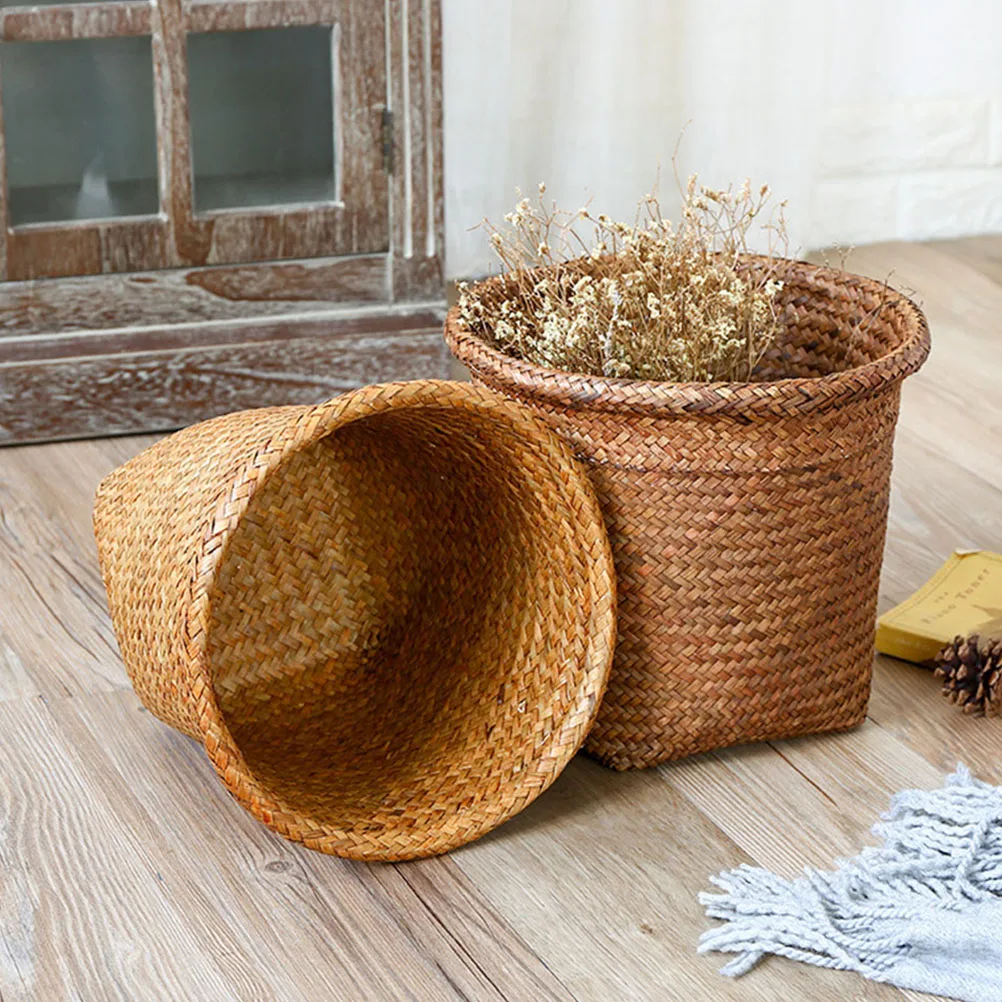
Questions to Consider Before Purchasing
Before making your final wicker material selection, ask yourself these important questions to ensure you choose the right option for your specific needs:
Location-Based Considerations
Where will the piece be used?
Indoor spaces with climate control are suitable for both materials, while outdoor or exposed locations strongly favor synthetic options. Consider whether the piece will be moved between locations seasonally.
What’s the climate like in your region?
High humidity areas like Florida or the Pacific Northwest present challenges for natural wicker, while extremely dry climates may require additional maintenance to prevent natural wicker from becoming brittle.
Is the location protected or exposed?
Even within indoor spaces, consider proximity to windows (UV exposure), heating vents (drying effects), or water sources (humidity and splashes) that might affect material performance.
Lifestyle Factors
How much maintenance time can you realistically commit?
Be honest about your willingness to perform regular maintenance. If you prefer minimal upkeep, synthetic options will better align with your lifestyle.
Do you have children or pets who will interact with the pieces?
Active households with young children or pets generally benefit from the durability and easy cleaning of synthetic wicker for frequently used items.
How frequently will the item be used?
Daily-use pieces face different demands than occasional accent items. High-traffic applications typically favor synthetic materials for their durability and consistent performance.
Aesthetic Priorities
What’s your overall design style?
Bohemian, coastal, and traditional designs often benefit from natural wicker’s organic qualities, while contemporary and modern spaces may be better served by the precision of synthetic options.
Is natural variation desirable or problematic for your design vision?
Some prefer the unique character variations in natural wicker, while others prefer the consistency of synthetic materials for more controlled design schemes.
What colors and finishes work best with your existing décor?
Natural wicker offers limited color options unless painted, while synthetic wicker provides extensive color possibilities to coordinate with existing elements.
Taking time to answer these questions honestly will help guide you toward the wicker material that best suits your practical needs while satisfying your aesthetic preferences. For those ready to explore options, our laundry solutions collection offers both natural and synthetic wicker pieces designed for specific household applications.
FAQs: Common Concerns About Wicker Materials
Can natural wicker be used outdoors at all?
Natural wicker can be used in covered outdoor spaces with protection from direct rain, standing water, and excessive humidity. Even with protection, natural wicker outdoors requires seasonal storage during harsh weather and more frequent maintenance. For best results, limit outdoor use to fair-weather periods and bring pieces indoors during inclement weather or seasonal extremes.
Does synthetic wicker feel “fake”?
Early generations of synthetic wicker often had an obviously plastic feel, but modern premium synthetic wicker has dramatically improved in tactile quality. High-quality HDPE synthetic wicker now features varied textures, subtle color variations, and appropriate flexibility that closely mimics natural materials. Budget options may still have a more obviously synthetic feel, but premium synthetic wicker can be surprisingly authentic to the touch.
How long does each material typically last?
Quality natural wicker properly maintained in suitable indoor environments typically lasts 7-15 years before requiring significant repair or replacement. Premium synthetic wicker can last 10-20 years outdoors and potentially longer indoors. However, lower-quality synthetic options (particularly PVC) may deteriorate within 2-5 years when exposed to harsh conditions.
Can damaged wicker be repaired?
Both materials can be repaired, but the processes differ. Natural wicker repair often requires specialized skills to weave in new natural materials and may be best handled by professionals for valuable pieces. Synthetic wicker repairs are typically more straightforward, often using clear adhesive or replacement sections that can be woven into the existing structure. The feasibility of repair depends on the extent of damage and the specific construction of the piece.
Is synthetic wicker environmentally friendly?
Traditional synthetic wicker derived from virgin petroleum products has a significant environmental footprint. However, newer eco-friendly options made from recycled plastics or incorporating biodegradable components offer improved environmental performance. Additionally, the extended lifespan of quality synthetic wicker means fewer replacement items over time, potentially reducing overall resource consumption compared to repeatedly replacing natural wicker that deteriorates.
Does natural wicker attract pests?
Properly finished and maintained natural wicker is not particularly attractive to common household pests. However, if left untreated or allowed to deteriorate, natural plant fibers can potentially attract insects. Regular cleaning and occasional application of natural oils helps prevent pest issues. Synthetic wicker does not attract pests under any circumstances.
Can I paint or refinish wicker furniture?
Both natural and synthetic wicker can be painted, though the processes differ. Natural wicker accepts paint readily but requires proper preparation with cleaning and priming. Water-based paints work well and should be applied in thin coats to avoid filling the weave spaces. Synthetic wicker requires specialized paints formulated for plastics and thorough surface preparation for proper adhesion. Both benefit from spray application rather than brushing to maintain the openness of the weave pattern.
For more specific information about materials used in laundry applications, our ultimate guide laundry basket materials addresses common questions about durability, maintenance, and suitable options for different household needs.
Final Thoughts: Making Your Perfect Wicker Selection
After exploring the detailed differences between natural and synthetic wicker materials, it’s clear that both options offer distinct advantages for home decor and storage solutions. Natural wicker brings organic warmth, authentic character, and artisanal craftsmanship that connects spaces to traditional techniques and natural materials. Synthetic wicker provides impressive durability, weather resistance, and low maintenance that accommodates busy lifestyles and challenging environments.
Rather than declaring one material universally superior, your ideal choice depends on your specific needs, environment, and preferences. Indoor spaces protected from moisture and direct sunlight can beautifully showcase the authentic appeal of natural wicker. Outdoor areas, bathrooms, or homes with young children may benefit more from synthetic wicker’s practical resilience.
Regardless of which material you select, prioritize quality construction. A well-crafted piece in either material will significantly outperform a poorly made alternative. Look for tight, consistent weaving, proper reinforcement at stress points, and appropriate weight for the item’s intended use.
Whenever possible, experience wicker pieces in person before purchasing. Touch the surfaces to assess comfort, test the strength of joints and connection points, and evaluate the overall craftsmanship that photographs alone cannot convey.
At Tidy Treasure, we carefully select premium wicker pieces in both natural and synthetic materials, ensuring that each item meets rigorous standards for quality, design, and functionality. Our collection is curated to provide beautiful organizing laundry wicker baskets and storage solutions that enhance your home’s aesthetic while delivering practical performance that stands the test of time.
Remember that the perfect wicker selection isn’t just about material—it’s about finding pieces that align with your lifestyle, complement your design vision, and provide the functionality you need to organize life beautifully.
